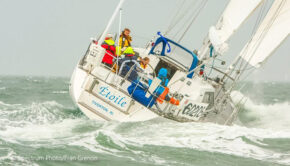Winning something is just a bonus
Published on August 17th, 2024
The biennial Marion Bermuda Race provides a 645 nm course for only Corinthian entries, attracting racer-cruiser that meet the requirements for cruising equipment. David Caso, who won his class in 2023 on his Cherubini 44 Silhouette, offers some advice for the 2025 edition:
Tell us a little bit about your mindset and preparation going into the 2023 race.
I have been participating in the Marion to Bermuda Race on Silhouette since 2005. Every race creates a perfect opportunity to go through the entire boat to look for broken or worn items.
The required equipment checklist is the perfect way to prepare the boat for an ocean voyage, whether racing or not. I believe that the boat needs to be in perfect condition with no deferred maintenance. When the equipment onboard is in great shape, then you can push the boat hard, if necessary, without concern.
We always try to keep the boat moving as fast as possible and as close as possible to the finish line. In 2023, I believe that paid off. We were chasing a possible Gulf Stream current that never really materialized when the wind died. Our premiere Helmsman, Mark Lindquist, used his very light touch on the wheel to keep the boat moving until we finally hit the current that propelled us ahead toward Bermuda.
What was it like to win your class?
It is fun just to race and finish. We always say that it is a successful race if we finish with everyone onboard and we don’t break or lose anything. Winning something is just a bonus. I don’t underestimate luck, but you need to put yourself in a position to get lucky.
Anything in particular you credit your success to?
I don’t think I am that good at racing sailboats. I am better at navigating and safely handling the boat than racing. I will defer to the crew for a collaborative effort. I always have great sailors on board and let them do what they do best.
It is never contentious. We all usually pose our intentions as questions. Instead of shouting an order, “Trim the main,” you will usually hear someone say, “Do you think we can squeeze out more speed if we bring the main in a bit?”. The answer usually is, “Let’s try it.” That tweaking process is constant.
Anything from the race that stands out?
We had the spinnaker up, and our most experienced crew member, Andre Martecchini, noticed a thunderhead on the horizon and said, “Do you think we should take the spinnaker down?” Without hesitation, everyone kicked into sail change mode.
After bagging the spinnaker, the wind picked up to 30 knots in the opposite direction. Having the preventor still on and the sails cleated on the opposite tack, the boat healed aggressively to starboard. On a 30-degree tilt, another crewman, Rick Evans, saved the bagged spinnaker from floating overboard, saving thousands of dollars from the sea.
After adjusting the sails for the proper tack, I was confident that we were going to meet our goal of finishing with everyone onboard and not losing any equipment.
Any advice for a new and/or hesitant skipper for 2025?
Don’t hesitate. In 2005, I had very little offshore experience, but if you follow the race requirements, you can be assured that your boat and crew will be ready.









 We’ll keep your information safe.
We’ll keep your information safe.